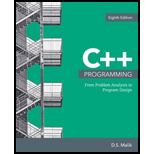
C++ Programming: From Problem Analysis to Program Design
8th Edition
ISBN: 9781337102087
Author: D. S. Malik
Publisher: Cengage Learning
expand_more
expand_more
format_list_bulleted
Textbook Question
Chapter 3, Problem 8SA
What does function sqrt do? Which header file must be included to use the function sqrt? (3)
Expert Solution & Answer
Want to see the full answer?
Check out a sample textbook solution
Students have asked these similar questions
Create a relationship between the common field (Technician Number) of the two tables. Make sure that each client must have 1 and only 1 technician assigned, and each technician can have multiple clients.
2. Create a query to show the Client Number, Client Name, Billed, Paid for clients in Anderson city. Save the query.
3. Create a query to show the Technician Number, Last Name, First Name, YTD Earnings for technicians whose Hourly Rate is greater than or equal to 30. Save the query.
4. Create a query to show Client Number, Client Name, Billed, Paid for clients whose technician number is 22 and whose Billed is over 300. Save the query.
5. Create a query to show the Technician Number, Last Name, First Name, Client Number, Client Name for clients whose technician number 23. Save the query.
6. Create a query to show the Technician Number, Last Name, First Name, Client Number, Client Name for clients whose technician number 23 or 29. Save the query Help please Microsoft office access
Dijkstra's Algorithm (part 1). Consider the network shown below, and Dijkstra’s link-state algorithm. Here, we are interested in computing the least cost path from node E (note: the start node here is E) to all other nodes using Dijkstra's algorithm. Using the algorithm statement used in the textbook and its visual representation, complete the "Step 0" row in the table below showing the link state algorithm’s execution by matching the table entries (i), (ii), (iii), and (iv) with their values. Write down your final [correct] answer, as you‘ll need it for the next question.
4. |z + 5 - 5i| = 7
Chapter 3 Solutions
C++ Programming: From Problem Analysis to Program Design
Ch. 3 - Mark the following statements as true or false. An...Ch. 3 - Prob. 7SACh. 3 - What does function sqrt do? Which header file must...Ch. 3 - Prob. 9SACh. 3 - Prob. 10SACh. 3 - 11. What is the purpose of the manipulator setw?...Ch. 3 - 12. What is the output of the following program?...Ch. 3 - Prob. 13SACh. 3 - Suppose that name is variable of type string. What...Ch. 3 - 16. Write a C++ statement that uses the...
Ch. 3 - 19. The following program is supposed to read the...Ch. 3 - Prob. 20SACh. 3 - Prob. 21SACh. 3 - 22. Suppose that infile is an ifstream variable...Ch. 3 - 24. Suppose that infile is an 18stream variable...Ch. 3 - 1. Consider the following incomplete C++ program:...Ch. 3 - 2. Consider the following program in which the...Ch. 3 - Write a program that prompts the user to enter the...Ch. 3 - 4. During each summer, John and Jessica grow...Ch. 3 - 5. Three employees in a company are up for a...Ch. 3 - 6. Write a program that accepts as input the mass,...Ch. 3 - Interest on a credit card's unpaid balance is...Ch. 3 - Prob. 8PECh. 3 - Dairy Farm decided to ship milk in containers in...Ch. 3 - 10. Paula and Danny want to plant evergreen trees...
Knowledge Booster
Learn more about
Need a deep-dive on the concept behind this application? Look no further. Learn more about this topic, computer-science and related others by exploring similar questions and additional content below.Similar questions
arrow_back_ios
SEE MORE QUESTIONS
arrow_forward_ios
Recommended textbooks for you
 C++ for Engineers and ScientistsComputer ScienceISBN:9781133187844Author:Bronson, Gary J.Publisher:Course Technology Ptr
C++ for Engineers and ScientistsComputer ScienceISBN:9781133187844Author:Bronson, Gary J.Publisher:Course Technology Ptr Systems ArchitectureComputer ScienceISBN:9781305080195Author:Stephen D. BurdPublisher:Cengage Learning
Systems ArchitectureComputer ScienceISBN:9781305080195Author:Stephen D. BurdPublisher:Cengage Learning C++ Programming: From Problem Analysis to Program...Computer ScienceISBN:9781337102087Author:D. S. MalikPublisher:Cengage LearningNp Ms Office 365/Excel 2016 I NtermedComputer ScienceISBN:9781337508841Author:CareyPublisher:CengageCOMPREHENSIVE MICROSOFT OFFICE 365 EXCEComputer ScienceISBN:9780357392676Author:FREUND, StevenPublisher:CENGAGE L
C++ Programming: From Problem Analysis to Program...Computer ScienceISBN:9781337102087Author:D. S. MalikPublisher:Cengage LearningNp Ms Office 365/Excel 2016 I NtermedComputer ScienceISBN:9781337508841Author:CareyPublisher:CengageCOMPREHENSIVE MICROSOFT OFFICE 365 EXCEComputer ScienceISBN:9780357392676Author:FREUND, StevenPublisher:CENGAGE L


C++ for Engineers and Scientists
Computer Science
ISBN:9781133187844
Author:Bronson, Gary J.
Publisher:Course Technology Ptr

Systems Architecture
Computer Science
ISBN:9781305080195
Author:Stephen D. Burd
Publisher:Cengage Learning

C++ Programming: From Problem Analysis to Program...
Computer Science
ISBN:9781337102087
Author:D. S. Malik
Publisher:Cengage Learning

Np Ms Office 365/Excel 2016 I Ntermed
Computer Science
ISBN:9781337508841
Author:Carey
Publisher:Cengage

COMPREHENSIVE MICROSOFT OFFICE 365 EXCE
Computer Science
ISBN:9780357392676
Author:FREUND, Steven
Publisher:CENGAGE L
Introduction to Computers; Author: Tutorials Point (India) Ltd.;https://www.youtube.com/watch?v=-AP1nNK3bRs;License: Standard YouTube License, CC-BY
Computers for Beginners: Introduction; Author: Carson City Library;https://www.youtube.com/watch?v=jH8pgGfG9HY;License: Standard Youtube License